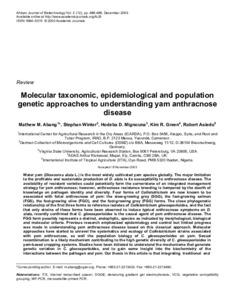| dc.contributor.author | Abang, Mathew M. |
| dc.contributor.author | Winter, S. |
| dc.contributor.author | Mignouna, H.D. |
| dc.contributor.author | Green, K.R. |
| dc.contributor.author | Asiedu, Robert |
| dc.date.accessioned | 2019-12-04T11:23:50Z |
| dc.date.available | 2019-12-04T11:23:50Z |
| dc.date.issued | 2003-12 |
| dc.identifier.citation | Abang, M.M., Winter, S., Mignouna, H.D., Green, K.R. & Asiedu, R. (2003). Molecular taxonomic, epidemiological and population genetic approaches to understanding yam anthracnose disease. African Journal of Biotechnology, 2(12), 486-496. |
| dc.identifier.issn | 1684-5315 |
| dc.identifier.uri | https://hdl.handle.net/20.500.12478/4177 |
| dc.description.abstract | Water yam (Dioscorea alata L.) is the most widely cultivated yam species globally. The major limitation to the profitable and sustainable production of D. alata is its susceptibility to anthracnose disease. The availability of resistant varieties could potentially form the cornerstone of an integrated management strategy for yam anthracnose; however, anthracnose resistance breeding is hampered by the dearth of knowledge on pathogen identity and diversity. Four forms of Colletotrichum are now known to be associated with foliar anthracnose of yam: the slow-growing grey (SGG), the fast-growing salmon (FGS), the fast-growing olive (FGO), and the fast-growing grey (FGG) forms. The close phylogenetic relationship of the first three forms to reference isolates of Colletotrichum gloeosporioides, and the fact that only strains of these forms have been observed to induce typical anthracnose symptoms on D. alata, recently confirmed that C. gloeosporioides is the causal agent of yam anthracnose disease. The FGG form possibly represents a distinct, endophytic, species as indicated by morphological, biological and molecular criteria. Previous research emphasized epidemiology and control but limited progress was made in understanding yam anthracnose disease based on this classical approach. Molecular approaches have started to unravel the systematics and ecology of Colletotrichum strains associated with yam anthracnose, as well the population biology of C. gloeosporioides on yam. Sexual recombination is a likely mechanism contributing to the high genetic diversity of C. gloeosporioides in yam-based cropping systems. Studies have been initiated to understand the mechanisms that generate genetic variation in C. gloeosporioides, and to gain some insight into the biochemistry of the interactions between the pathogen and yam. Our thesis in this article is that integrating traditional and molecular approaches to understanding C. gloeosporioides systematics, epidemiology and population genetics will lead to a much better understanding of yam anthracnose disease, and thus to the development of effective and sustainable control measures. Research successes and challenges are discussed, as well as their implications for future studies on pathogen evolutionary potential, anthracnose resistance breeding, and the deployment of resistance genes. |
| dc.language.iso | en |
| dc.subject | Anthracnose |
| dc.subject | Colletotrichum Gloeosporioides |
| dc.subject | Dioscorea |
| dc.subject | Molecular Markers |
| dc.subject | Yams |
| dc.title | Molecular taxonomic, epidemiological and population genetic approaches to understanding yam anthracnose disease |
| dc.type | Journal Article |
| dc.type | Journal Article |
| dc.description.version | Peer Review |
| cg.contributor.crp | Roots, Tubers and Bananas |
| cg.contributor.affiliation | International Center for Agricultural Research in the Dry Areas |
| cg.contributor.affiliation | Deutsche Sammlung von Mikroorganismen und Zellkulturen |
| cg.contributor.affiliation | Virginia State University |
| cg.contributor.affiliation | ADAS Arthur Rickwood |
| cg.contributor.affiliation | International Institute of Tropical Agriculture |
| cg.coverage.region | Africa |
| cg.coverage.region | West Africa |
| cg.coverage.country | Nigeria |
| cg.authorship.types | CGIAR and advanced research institute |
| cg.iitasubject | Yam |
| cg.accessibilitystatus | Open Access |
| local.dspaceid | 99743 |
| cg.identifier.doi | https://doi.org/10.5897/AJB2003.000-1098 |

